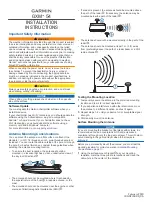
ADCP-75-192 • Issue 2 • June 2007
Page 34
© 2007, ADC Telecommunications, Inc.
There can be many CPUs at a single Hub Site within the many racks and chassis, but there is no
way to correlate an IP address to its physical rack/chassis location automatically. Therefore, a
convention for identifying racks and chassis needs to be established. At installation time, each
hostname, as written on the front tag of each CPU, must be recorded in conjunction with its
physical location. This information is used when the operator fills in the Hub Node MIB, which
is discussed in detail below. Digivance CXD/NXD Hub naming conventions are also discussed
below.
The Hub Node MIB correlates Hub node IP addresses with their hostnames and physical
locations. It resides solely at Hubmaster nodes. Refer to Section 11.1 for details.
3.6.2
Identification Using the Network IP Receiver/Sender (NIP R/S)
The Digivance CXD/NXD Hubmaster node dynamically keeps track of which nodes are under
its control using a script called NIPR/S (Network IP Receiver/Sender). It receives an IP and
hostname from each element in the subnet it controls via the client functionality of NIPR/S,
which runs on all “slave” nodes. NIPR/S senses any changes to its list of slave nodes, and
updates the Hubmaster DNS accordingly. The NIPR/S script is also a key component to
maintaining the HUB/RAN Node MIBs and, ultimately, tenant processing as a whole, since it is
the mechanism by which the HUB/RAN Node MIB entries are filled.
There are two main ways to access the output of NIPR/S for use in the identification of related
nodes. The most accessible way is to utilize SNMP to view the Hub Node MIB and RAN Node
MIB at the Hubmaster node. To get an unbroken list of Digivance CXD/NXD IP addresses that
the Hubmaster is currently servicing, telnet into the Hubmaster node on port 7401. No user
name or password is necessary. The output format is a series of text strings, each containing an
IP preceded by a “+” or “-” and terminated with a line feed. The Hubmaster is always the first
entry in the list.
An example of a typical output for a five-node system is shown in
Figure 10. Typical NIPR/S Output Using Telnet
The “+” indicates the IP has been added to the list. A “-“ would indicate the IP has been
removed from the list. This would occur, for example, if the communication link to that node
was removed due to a power shutdown or other disruption.
+172.20.1.1
+172.20.1.249
+172.20.1.250
+172.20.1.246
+172.20.1.247
+172.20.1.242
Содержание Digivance CXD
Страница 12: ...ADCP 75 192 Issue 2 June 2007 Preface Page 10 2007 ADC Telecommunications Inc ...
Страница 73: ......
Страница 74: ...i www adc com ...
















































